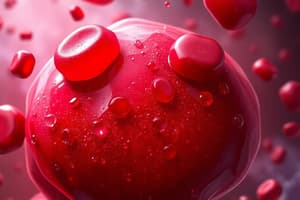Podcast
Questions and Answers
What is the molecular structure of fetal hemoglobin?
What is the molecular structure of fetal hemoglobin?
- [ζ₂γ₂] (2 zeta, 2 gamma)
- [ζ₂ε₂] (2 zeta, 2 epsilon)
- [α₂γ₂] (2 alpha, 2 gamma) (correct)
- [α₂β₂] (2 alpha, 2 beta)
Which type of hemoglobin is not present in adults?
Which type of hemoglobin is not present in adults?
- Gower I (correct)
- Gower II (correct)
- Portland (correct)
- Fetal Hgb (correct)
What proportion of fetal hemoglobin is typically found in newborns?
What proportion of fetal hemoglobin is typically found in newborns?
- 80% (correct)
- 40%
- 100%
- 60%
Which of the following hemoglobin forms has a molecular structure of [ζ₂γ₂]?
Which of the following hemoglobin forms has a molecular structure of [ζ₂γ₂]?
In which stage of life is Gower I hemoglobin found in significant proportions?
In which stage of life is Gower I hemoglobin found in significant proportions?
Flashcards
Portland Hemoglobin
Portland Hemoglobin
A type of hemoglobin with a molecular structure of [ζ₂γ₂] (2 zeta, 2 gamma), present only in newborns.
Gower I Hemoglobin
Gower I Hemoglobin
A type of hemoglobin with a molecular structure of [ζ₂ε₂] (2 zeta, 2 epsilon), present only at trace amounts in newborns.
Gower II Hemoglobin
Gower II Hemoglobin
A type of hemoglobin with a molecular structure of [α₂ε₂] (2 alpha, 2 epsilon), present only at trace amounts in newborns.
Fetal Hemoglobin
Fetal Hemoglobin
Signup and view all the flashcards
Hemoglobin structure in newborns
Hemoglobin structure in newborns
Signup and view all the flashcards
Hemoglobin structure in adults
Hemoglobin structure in adults
Signup and view all the flashcards
Study Notes
Hemoglobin Forms
- Hemoglobin types vary depending on the stage of life and have different proportions in newborns and adults
- Portland: 2 zeta, 2 gamma (0% in newborns and adults)
- Gower I: 2 zeta, 2 epsilon (0% in newborns and adults)
- Gower II: 2 alpha, 2 epsilon (0% in newborns and adults)
- Fetal Hgb: 2 alpha, 2 gamma (80% in newborns and <1% in adults)
- A1/A: 2 alpha, 2 beta (20% in newborns and 97% in adults)
- A2: 2 alpha, 2 delta (<0.5% in newborns and 2.5% in adults)
Hemoglobin Derivatives
- Oxyhemoglobin (Hb O₂): Iron bound to oxygen, found in arterial blood (bright red) and is in the relaxed state
- Deoxygenated hemoglobin: Iron not bound to oxygen, found in venous blood (dark red), and it is in the tense state
- Carboxyhemoglobin (HbCO): Iron bound to carbon monoxide (CO), colorless gas, produced by humans. A poison that is silent. A killer, causes dizziness, nausea and exhaust from car - 240 times greater affinity to Hb than O2; cherry red color of blood and skin in CO poisoning
Dyshemoglobins
- Methemoglobin (Hi/Hemoglobin): Iron is in the ferric (Fe³⁺) state, can't bind to O₂, causes chocolate-brown color to blood.
- Sulfhemoglobin (SHb): Not measured by cyanmethaemoglobin method, mixture of oxidized, partially denatured Hb. Causes include prolonged constipation, bacteremia (C. perfringens), and enterogerous cyanosis; lavender-colored blood.
Studying That Suits You
Use AI to generate personalized quizzes and flashcards to suit your learning preferences.




